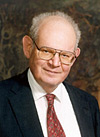
Benoit Mandelbrot
for his pioneering work in introducing the concepts of fractal geometry and discovering the underlying simplicity of scale-independent phenomena, and for demonstrating their application in a wide variety of fields in geophysics and other areas of physical science
The work of B. Mandelbrot
encompasses other geophysical domains, in particular hydrology and
geomorphology. Furthermore,
the mushrooming interest in fractal and scaling notions has touched
almost every geophysical field. In a general manner, it has been a
milestone in the quest for simplicity defining complexity and as an
impressive use of scale invariance in nonlinear phenomena: complex shapes,
which are so common in geophysics
Last but not the least, the
use of the 'Fractal geometry' to deal with scale invariant geometric sets
of points eventually lead to the consideration of the notion of
multifractal fields, which turn out to be rather ubiquitous in geophysics.
Thanks to these developments, we have another way of looking at Nonlinear
Phenomena in Geophysics: the
complexity of shapes
could become related to the singularities of the nonlinear
generating equations, and the latter could be also created and described
by simple rules.
Newsletter 59, 36, 1996